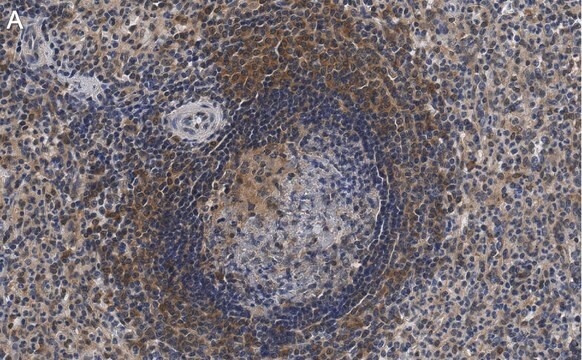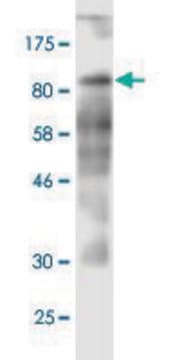MABT1548
Anti-CD97 Antibody, clone CLB‐CD97/1
Sinónimos:
Adhesion G protein-coupled receptor E5, Leukocyte antigen CD97
About This Item
Productos recomendados
biological source
mouse
Quality Level
antibody form
purified antibody
antibody product type
primary antibodies
clone
CLB?CD97/1, monoclonal
mol wt
calculated mol wt 92 kDa
observed mol wt ~N/A kDa
purified by
using protein G
species reactivity
human
packaging
antibody small pack of 100
technique(s)
ELISA: suitable
flow cytometry: suitable
immunofluorescence: suitable
immunohistochemistry: suitable
immunoprecipitation (IP): suitable
inhibition assay: suitable
isotype
IgG2a
epitope sequence
N-terminal extracellular domain
Protein ID accession no.
UniProt accession no.
storage temp.
-10 to -25°C
Gene Information
human ... ADGRE5(976)
Specificity
Immunogen
Application
Evaluated by Flow Cytometry in THP-1 cells.
Flow Cytometry Analysis: 1.0 µg of this antibody detected CD97 in one million THP-1 cells.
Tested Applications
Flow Cytometry Analysis: A representative lot detected CD97 in Flow Cytometry applications (Hamann, J., et al. (1996). 184(3):1185-9; Kwakkenbos, M.J., et al. (2002). J Leukoc Biol. 71(5):854-62).
Inhibition Assay: A representative lot of this antibody inhibited erythrocyte adhesion to CD97-transfected COS cells.(Hamann, J., et al. (1996). 184(3):1185-9; Hamann, J., et al. (1998). Eur J Immunol.;28(5):1701-7).
Immunoprecipitation Analysis: A representative lot immunoprecipitated CD97 in Immunoprecipitation applications (Hamann, J., et al. (1996). 184(3):1185-9).
Immunohistochemistry Applications: A representative lot detected CD97 in Immunohistochemistry applications (Hamann, J., et al. (1999). Arthritis Rheum. 42(4):650-8; Steinert, M., et al. (2002). Am J Pathol. 161(5):1657-67).
Immunofluorescence Analysis: A representative lot detected CD97 in Immunofluorescence applications (Hamann, J., et al. (1998). Eur J Immunol. 28(5):1701-7; Hamann, J., et al. (1999). Arthritis Rheum. 42(4):650-8; Steinert, M., et al. (2002). Am J Pathol. 161(5):1657-67).
ELISA Analysis: A representative lot detected CD97 in ELISA applications (Hamann, J., et al. (1999). Arthritis Rheum. 42(4):650-8; Steinert, M., et al. (2002). Am J Pathol. 161(5):1657-67).
Note: Actual optimal working dilutions must be determined by end user as specimens, and experimental conditions may vary with the end user.
Target description
Physical form
Reconstitution
Storage and Stability
Other Notes
Disclaimer
¿No encuentra el producto adecuado?
Pruebe nuestro Herramienta de selección de productos.
Storage Class
12 - Non Combustible Liquids
wgk_germany
WGK 2
flash_point_f
Not applicable
flash_point_c
Not applicable
Certificados de análisis (COA)
Busque Certificados de análisis (COA) introduciendo el número de lote del producto. Los números de lote se encuentran en la etiqueta del producto después de las palabras «Lot» o «Batch»
¿Ya tiene este producto?
Encuentre la documentación para los productos que ha comprado recientemente en la Biblioteca de documentos.
Nuestro equipo de científicos tiene experiencia en todas las áreas de investigación: Ciencias de la vida, Ciencia de los materiales, Síntesis química, Cromatografía, Analítica y muchas otras.
Póngase en contacto con el Servicio técnico







